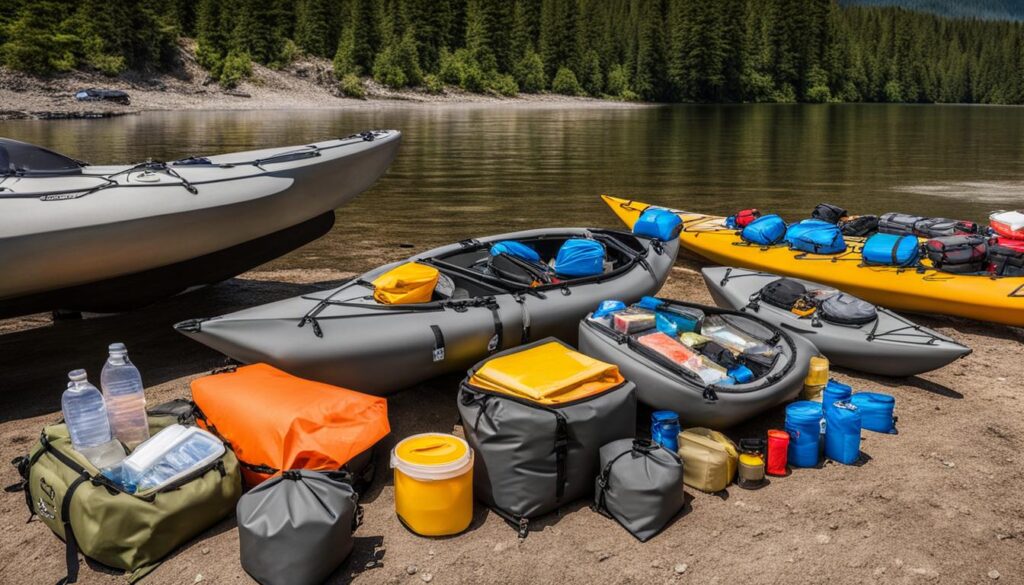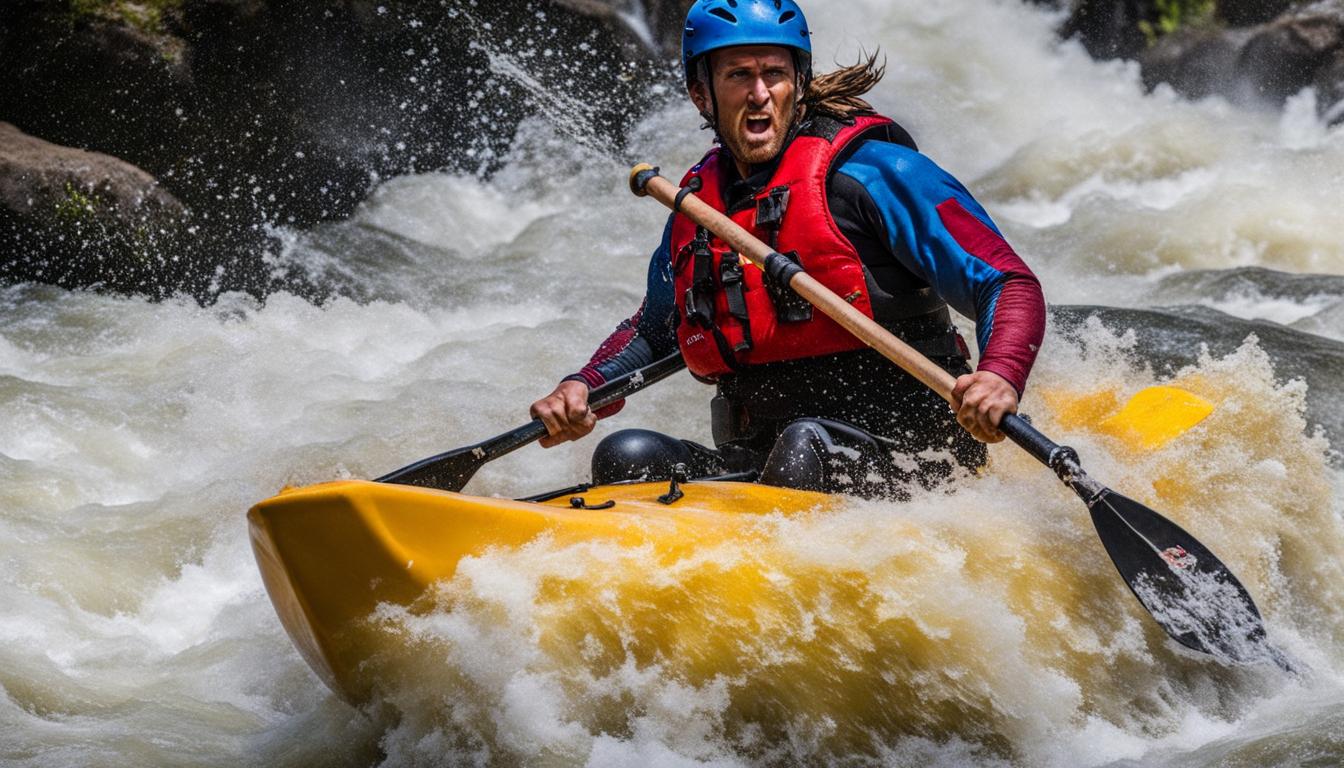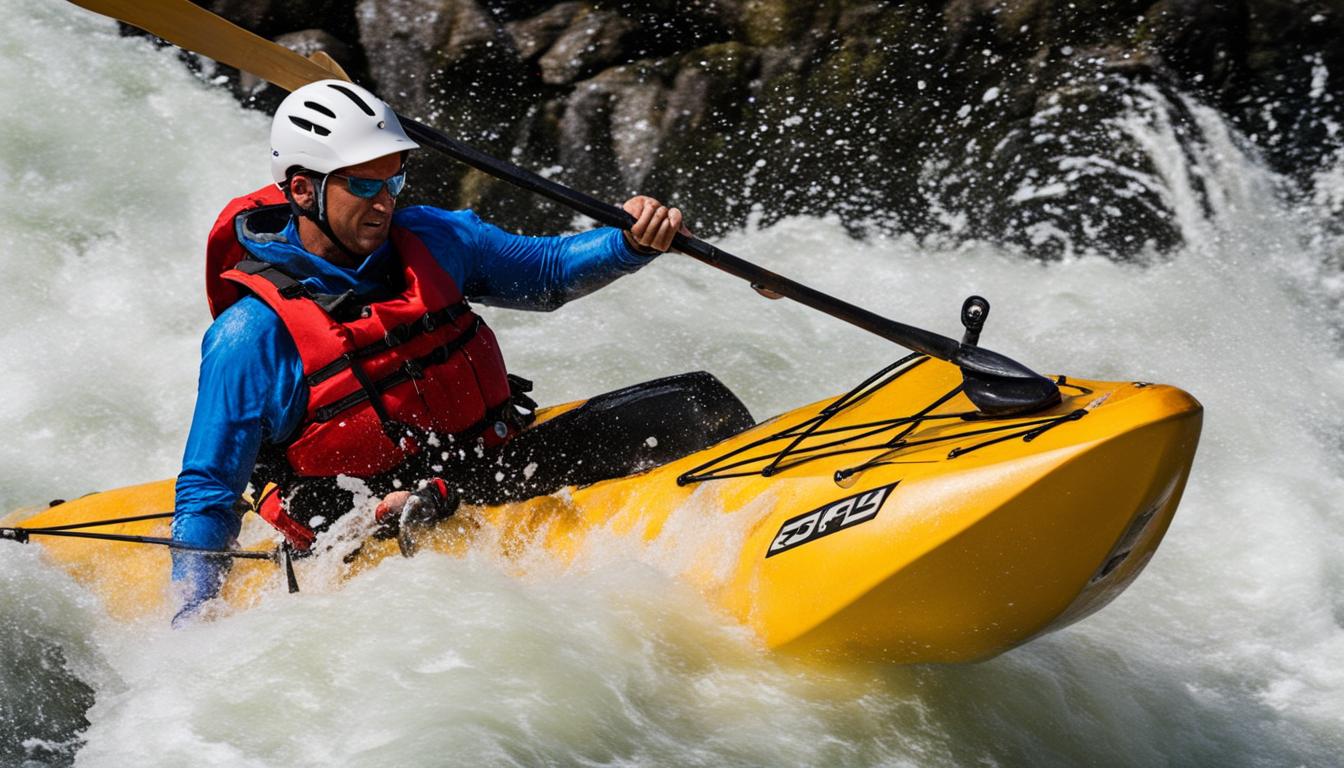When planning a sea kayaking trip, it’s important to figure out the best way to store your food and supplies to ensure they stay dry and fresh throughout your adventure. This article will provide tips and techniques for efficiently packing and organizing your meals and gear while on a kayak trip.
Key Takeaways:
- Proper food and supply storage is crucial for sea kayaking trips.
- Choose the right cooler that fits in your kayak and provides insulation.
- Consider using one medium cooler or two small coolers to organize your food.
- Try creative tips for extended kayak camping food storage, like freezing water bottles and using thermoses.
- Meal planning is important for nutritional needs and energy requirements.
Choosing the Right Cooler for Your Kayak
When it comes to kayak trip food storage, finding the right cooler is essential to ensure your food stays fresh and your gear is efficiently organized. Managing kayak storage space can be challenging, but there are efficient solutions available that can help maximize the limited room on your kayak. Compact storage for kayaking is crucial for a successful trip.
One option to consider is the Icemule Boss cooler, which offers insulation and a dry bag-style closure. It is designed to fit in tight spaces, making it a great choice for kayaking. Another option is the Engel roll-top cooler, which provides insulation and a secure closure that prevents leaking.
For smaller kayaks with limited space, it may be necessary to choose a cooler that can fit underneath the spray deck or on top of the deck between the cockpits. Styrofoam boards can also be used to create compartments within the cooler, allowing you to separate different types of food and supplies.
When selecting a cooler for your kayak trip, consider the dimensions of your kayak, the amount of food and supplies you need to store, and the accessibility of the cooler during your trip. By choosing the right cooler and utilizing efficient storage techniques, you can ensure that your food stays fresh and your gear is readily accessible throughout your sea kayaking adventure.
Table: Comparison of Kayak Cooler Options
| Cooler | Features | Dimensions |
|---|---|---|
| Icemule Boss | Insulation, dry bag-style closure | 12″ x 14″ x 16″ |
| Engel Roll-Top | Insulation, secure closure | 15.6″ x 10.8″ x 12.4″ |
Choosing the right cooler for your kayak trip can make a significant difference in your overall experience. Don’t underestimate the importance of efficient storage solutions and managing kayak storage space. Your food and gear will thank you!
Choosing Between One Medium Cooler or Two Small Coolers
When embarking on a sea kayaking trip, deciding on the size and number of coolers for your supplies is crucial for efficient provisioning and organization. One of the primary considerations is whether to opt for one medium-sized cooler or two smaller coolers. Each option offers its own set of advantages and disadvantages, and the choice ultimately depends on your specific needs and preferences.
One Medium Cooler: With a single cooler, you can separate your food into compartments to maintain freshness and prevent cross-contamination. For example, you can place ice and meat at the bottom and store vegetables, cold cuts, and cheese on top. This method allows for easy access to different categories of food and keeps everything neatly organized in one place. Additionally, using styrofoam shipping containers to further divide the cooler into sections can provide additional insulation, ensuring better cooling and preserving the quality of your supplies.
Two Small Coolers: Opting for two smaller coolers offers more flexibility in terms of organization and access to specific items. By keeping meat in one cooler and vegetables in the other, you can avoid any potential spoilage or cross-contamination between food categories. Alternatively, you can divide your supplies for the first and second half of your trip, ensuring you always have fresh ingredients available. Additionally, using smaller coolers may allow you to distribute the weight more evenly in your kayak and make it easier to find space for them.
| Pros of One Medium Cooler | Pros of Two Small Coolers |
|---|---|
| – Easy organization with separate compartments | – Flexibility in accessing specific items |
| – Efficient use of space in the kayak | – Reduced risk of spoilage or cross-contamination |
| – Additional insulation with styrofoam dividers | – Even weight distribution in the kayak |
Ultimately, the choice between one medium cooler and two small coolers depends on your personal preferences, kayak storage capacity, and the length of your trip. Consider the specific requirements of your adventure and evaluate the advantages and disadvantages of each option to ensure you have a well-organized and properly provisioned sea kayaking experience.
Creative Tips for Extended Kayak Camping Food Storage
When embarking on an extended kayak camping trip, effective food storage is essential for ensuring your meals stay fresh and edible. Here are some creative tips to help you maximize your kayak’s storage space and keep your food in optimal condition throughout your adventure.
Freeze Water Bottles for Dual Purpose
One clever tip is to freeze water bottles before your trip and use them as ice packs in your cooler. As they gradually thaw, you can drink the water, saving space and reducing waste. This dual-purpose solution not only keeps your food cool but also helps you stay hydrated during your kayak camping excursion.
Use Cooler Liners and Towels for Extra Insulation
To enhance the insulation of your cooler, consider lining it with cooler-specific liners and placing towels on top of your food items. These additional layers provide extra insulation, helping to maintain the desired temperature within your cooler for a longer period. This simple step can make a significant difference in preserving the freshness and quality of your food.
Utilize Thermoses for Frozen Food Storage
If you want to bring fresh meat or pre-cooked meals to more remote locations, thermoses are a fantastic asset. Fill thermoses with frozen meals or meat before your trip, and they will stay frozen for an extended period. This enables you to enjoy a hearty and delicious meal even in the most secluded kayak camping spots.
| Benefits of Creative Food Storage Tips | Key Takeaways |
|---|---|
| 1. Dual-purpose freeze water bottles for cooling and drinking. | – Save space – Stay hydrated |
| 2. Use cooler liners and towels for enhanced insulation. | – Preserve freshness – Extend storage time |
| 3. Utilize thermoses for frozen food storage. | – Enjoy fresh meals – Ideal for remote locations |
By incorporating these creative tips into your extended kayak camping food storage strategy, you can prolong the life of your food, optimize space, and have a more enjoyable dining experience during your adventure.
Importance of Meal Planning for Sea Kayaking Trips
Proper meal planning is essential for a successful sea kayaking trip. Not only does it ensure that you have enough food to sustain you throughout your adventure, but it also helps you meet the nutritional needs of paddlers and account for the energy requirements of long days of paddling. In addition, meal planning allows you to consider any dietary restrictions or preferences of your group members, ensuring that everyone is well-fed and satisfied.
When planning your meals, it is important to balance carbohydrates, proteins, and fats to provide the necessary fuel for your physical activities. Pack meals that are easy to prepare and won’t spoil quickly, as refrigeration options may be limited. Consider non-perishable and compact food options such as canned goods, noodles, and dehydrated meals. These types of food are lightweight and require minimal cooking, making them ideal for kayak camping.
Organize your meals in advance and pack them in separate, labeled bags for easy access and organization. This will save you time and effort when it comes to meal preparation. It is also a good idea to have a backup plan in case of unexpected weather conditions or changes to your itinerary. Packing extra snacks and emergency food supplies can provide peace of mind and ensure that you are prepared for any situation that may arise during your sea kayaking trip.
Fueling your Adventures
Proper meal planning is the key to fueling your sea kayaking adventures. By considering the nutritional needs of paddlers, balancing your meals, and packing food that is easy to prepare and won’t spoil quickly, you can ensure that you have the energy and sustenance you need for a successful and enjoyable trip.

Tips for Efficient Packing and Organizing of Kayak Gear
When embarking on a sea kayaking trip, it’s important to pack and organize your gear efficiently to ensure a smooth and enjoyable adventure. Proper gear storage can make a significant difference in the comfort and convenience of your trip. Here are some tips for efficiently packing and organizing your kayak gear:
Use Dry Bags for Effective Gear Organization
Invest in a variety of dry bags to keep your gear dry and organized. Different sizes of dry bags can accommodate various items, such as sleeping bags, clothing, camera gear, electronics, books and maps, medical kits, and miscellaneous gear. Choose durable and lightweight dry bags that suit the type of gear you need to pack. Packing gear in separate bags based on categories will allow you to easily locate items when needed.
“Using dry bags for gear organization not only keeps your gear dry, but it also helps you stay organized during your kayak trip. With everything neatly packed and categorized, you can easily find what you need without rummaging through a jumble of gear.”
Test Gear Arrangement Before Your Trip
Before setting out on your kayak trip, it’s essential to test the arrangement of your gear to ensure everything fits properly. Pack your gear into your kayak, making adjustments as necessary to optimize space utilization. By testing the arrangement beforehand, you can identify any potential packing issues and make adjustments accordingly. This will save you time and frustration once you’re on the water.
Maximize Space with Strategic Packing
Efficient packing is all about maximizing space in your kayak. Consider the shape of your kayak and pack accordingly. Utilize every available nook and cranny, including the bow and stern compartments, cockpit, and deck space. Place heavier items closer to the center of the kayak to maintain stability. Use soft items, like clothing or sleeping bags, to fill in gaps and provide cushioning. By strategically packing your gear, you can optimize space and ensure a well-balanced kayak.

By following these tips for efficient packing and organizing of kayak gear, you can make the most of your sea kayaking trip. With everything neatly packed, dry, and easily accessible, you’ll have a stress-free and enjoyable adventure on the water.
Conclusion
In conclusion, proper food and supply storage is crucial for your sea kayaking trips. By following the tips and techniques mentioned in this article, you can ensure that your food stays fresh and your gear remains organized throughout your adventure.
When it comes to food storage, choosing the right cooler is essential. Consider the dimensions of your kayak and opt for coolers that provide insulation and secure closures. Styrofoam boards or shipping containers can help with compartmentalizing your cooler and improving cooling capability.
Furthermore, meal planning is important to meet the nutritional needs of paddlers and prepare for potential weather challenges. Pack meals that are easy to prepare and won’t spoil quickly, while considering dietary restrictions or preferences of your group members. Remember to label and separate meals in individual bags for easy organization.
Lastly, efficient packing and organizing of your gear is key. Use dry bags of different sizes to keep your gear dry and categorized. Test the arrangement of your gear before your trip to ensure a proper fit. With these strategies in place, you’ll be well-equipped for a successful sea kayaking adventure.
FAQ
What is the best way to store food and supplies on a sea kayaking trip?
It’s important to choose the right cooler for your kayak and consider the dimensions of your kayak when deciding on the size and number of coolers. Divide the cooler into sections for different types of food and use styrofoam shipping containers for extra insulation. Also, consider using freeze water bottles as ice packs and thermoses to freeze fresh food. Choose non-perishable and compact food options for longer trips.
How should I plan meals for a sea kayaking trip?
Proper meal planning is crucial for sea kayaking trips. Consider the nutritional needs of paddlers, the energy requirements for long days of paddling, and any dietary restrictions or preferences. Balance carbohydrates, proteins, and fats in your meals and pack meals that are easy to prepare and won’t spoil quickly. Plan meals in advance and pack them in separate, labeled bags for easy organization.
How should I pack and organize gear for a kayak trip?
Use dry bags to keep your gear dry and organized. Pack gear in separate bags based on categories, such as sleeping bags, clothing, camera gear, electronics, books and maps, medical kits, and miscellaneous gear. Consider the durability and weight of the dry bags based on the type of gear you’re packing. Test the arrangement of your gear before your trip to ensure everything fits properly.
What are some tips for efficiently packing and organizing gear in a kayak?
Use dry bags of different sizes to accommodate various items. Consider the type of gear you’re packing and choose the appropriate dry bags based on durability and weight. Pack gear in separate bags based on categories to easily locate items when needed. Test the arrangement of your gear before your trip to ensure everything fits properly.
Why is proper food and supply storage important for sea kayaking trips?
Proper food and supply storage ensures that you have access to fresh and dry supplies throughout your adventure. It helps keep your food fresh and your gear organized, making your trip more enjoyable and efficient.





